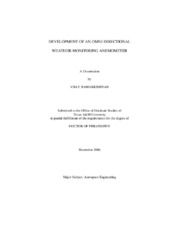| dc.description.abstract | This work presents the design, fabrication, calibration and testing of a pressure-based
three-component anemometer capable of measuring accurate wind speeds in extreme
weather conditions. The groundwork, at the outset, covers the development of a 12-hole
omni-directional flow-velocity measurement probe capable of measuring flows up to
155° from the probe axis. The new 12-hole design is optimal in the sense that the
calculation of the four unknown flow quantities, i.e., two flow angles, flow speed and
static pressure, is achieved with the minimum necessary number of holes/ports on the
probe tip. The fact that this design has 33% lesser number of holes compared to an
earlier design, has significant implications in the instrument’s spatial resolution,
frequency response as well as cost of interfacing and usage. A prototype 12-hole probe
with a spherical tip diameter of 3/8 inches was fabricated and tested. Good flow
prediction accuracy was obtained.
Further groundwork on multi-hole probe technology was carried out, developing new
methods for correcting and refining the calibration and reduction procedures. When
calibrating multi-hole velocity probes in a wind-tunnel, offset (or bias) errors often exist
in the recorded flow angles due to errors in aligning the traverse system exactly with the
flow direction and due to the angularity of the tunnel flow itself. These offset angles are
hard to quantify from direct measurements with any degree of accuracy. Although
usually small (less than 0.5° in most good calibrations), these errors still need to be corrected to increase the flow measurement accuracy of the probe. In this work, a
method is developed that computes offset errors in all types of multi-hole probes – from
the traditional 5- and 7-hole probes to the omni-directional 18-hole probe and the nextgeneration
12-hole probe – using simply the pressure data obtained during their
calibration. The algorithm doubled the measurement accuracy for most probes. Other
issues related to post-processing of the pressure data from flow studies, when the multihole
probe encountered unsteady and reversed flow conditions, were also examined.
The design of the anemometer (herein called a Weatherprobe) builds on that of the 12-
hole probe and is capable of measuring wind velocities up to ±45° to the horizontal plane
and 360° around the horizontal plane. Due to the non-conventional arrangement of its
pressure ports, newly developed calibration and data-reduction algorithms were used.
The probe was calibrated and its measurement accuracy assessed in a calibration facility.
All associated instrumentation was assembled from the ground up and ruggedized for
harsh-weather applications. Field tests performed over many days next to a 3-D sonic
anemometer showed good agreement in measured flow properties, thus validating the
entire Weatherprobe system. This probe has widespread applications in weather
monitoring, wind energy potential estimations and structural wind load evaluations. | en |


